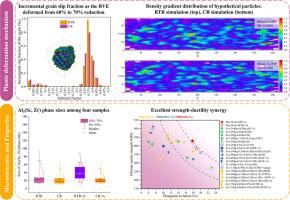Achieving superior thermal stability in an Al-Mg-Mn-Sc alloy by suppressing Al3(Sc, Zr) phase aggregation subjected to cryogenic homogeneous deformation
IF 12.8
1区 材料科学
Q1 ENGINEERING, MECHANICAL
引用次数: 0
Abstract
Nanometer precipitates are essential for enhancing high specific strength in aluminum alloys, yet their coarsening at elevated temperatures causes severe property degradation. Recently, second-phase engineering for tailoring precipitate size and spatial distribution in the matrix has become a recent research hotspot. Here, we report that cryorolling (CR) refines and homogenizes Al3(Sc,Zr) precipitates in an Al-Mg alloy containing scandium and zirconium, yielding exceptional thermal stability and mechanical performance. Crystal plasticity simulations were carried out for cryogenic and room-temperature deformation behaviors, which reveal that CR promotes a more coordinated strain distribution, accumulation of high-density dislocations under high stress and stress gradient, activation of hard-oriented slip systems, and coordinated operation of multiple slip systems, resulting in a more uniform deformation path than room-temperature rolling (RTR). The resulting precipitate refinement and uniform deformation minimize spatial clustering of Al3(Sc,Zr), suppressing short-range diffusion of Sc and Zr and retarding the coarsening kinetics of Al3(Sc,Zr). After annealing at 480 °C for 1 h, the average particle size of the Al₃(Sc,Zr) phase in the CR samples remained essentially unchanged. In contrast, the Al₃(Sc,Zr) phase in the RTR samples underwent significant coarsening, exhibiting an average particle size 71 % larger than that in the CR samples. Because Al3(Sc,Zr) impedes grain-boundary migration and dislocation climb at elevated temperatures, the fine-grained microstructure and high dislocation density in the CR material are retained, leading to superior thermal stability during annealing. This study demonstrates a promising route for enhancing the thermal stability of high-strength aluminum alloys that is readily scalable to industrial production.

通过抑制低温均匀变形下的Al3(Sc, Zr)相聚集,实现Al-Mg-Mn-Sc合金优异的热稳定性
纳米析出物对于提高铝合金的高比强度是必不可少的,但它们在高温下的粗化会导致许多缺陷。
本文章由计算机程序翻译,如有差异,请以英文原文为准。
求助全文
约1分钟内获得全文
求助全文
来源期刊

International Journal of Plasticity
工程技术-材料科学:综合
CiteScore
15.30
自引率
26.50%
发文量
256
审稿时长
46 days
期刊介绍:
International Journal of Plasticity aims to present original research encompassing all facets of plastic deformation, damage, and fracture behavior in both isotropic and anisotropic solids. This includes exploring the thermodynamics of plasticity and fracture, continuum theory, and macroscopic as well as microscopic phenomena.
Topics of interest span the plastic behavior of single crystals and polycrystalline metals, ceramics, rocks, soils, composites, nanocrystalline and microelectronics materials, shape memory alloys, ferroelectric ceramics, thin films, and polymers. Additionally, the journal covers plasticity aspects of failure and fracture mechanics. Contributions involving significant experimental, numerical, or theoretical advancements that enhance the understanding of the plastic behavior of solids are particularly valued. Papers addressing the modeling of finite nonlinear elastic deformation, bearing similarities to the modeling of plastic deformation, are also welcomed.
 求助内容:
求助内容: 应助结果提醒方式:
应助结果提醒方式:


